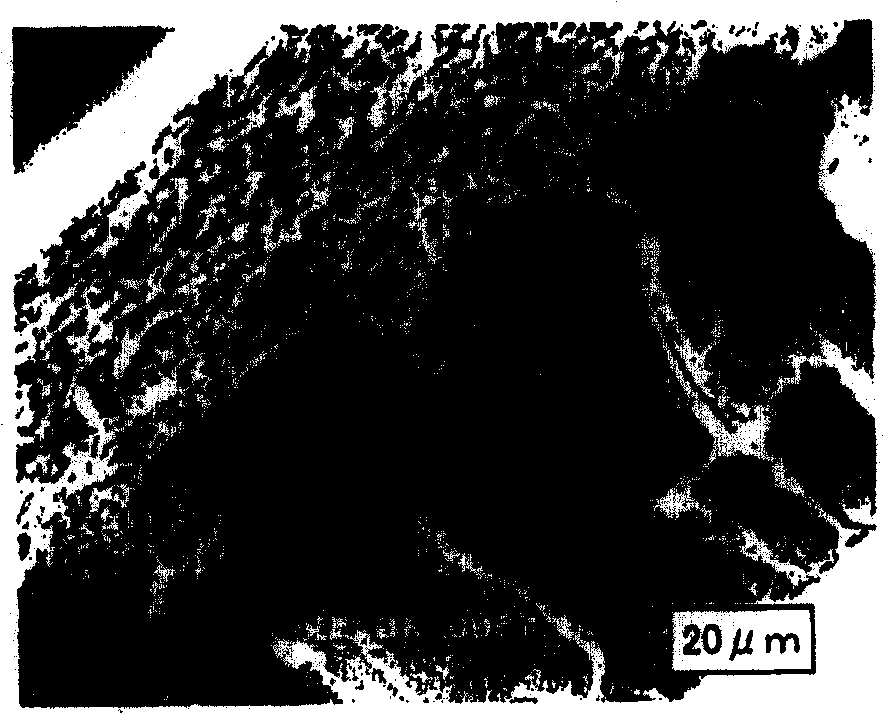Porous membrane of poly(metaphenylene isophthalamide) and process for producing the same
A technology of polym-phenylene isophthalamide and its manufacturing method, which is applied in the field of porous membrane and its manufacturing, and can solve the problems of increased average pore size and unsuitability
- Summary
- Abstract
- Description
- Claims
- Application Information
AI Technical Summary
Problems solved by technology
Method used
Image
Examples
Embodiment 1
[0140] Porous membranes were produced under the conditions shown in Table 1. Specific steps are as follows.
[0141] The CONEX polymer was dissolved in N-methyl-2-pyrrolidone and adjusted so that the concentration of polym-phenylene isophthalamide was 10% by weight. The dope was cast onto a polypropylene film (at 140 g / cm 2 The contact pressure was applied 30 times on the rubbing treatment) so that the thickness was 140 μm. Next, the cast product was put into a 15° C. coagulation bath containing 60% by weight of N-methyl-2-pyrrolidone and 40% by weight of water for 5 minutes to obtain a coagulated film. Then, the solidified film was peeled off from the polypropylene film, and immersed in a water bath at 50° C. for 30 minutes. Furthermore, this solidified film was treated at 120° C. for 30 minutes, and then at 270° C. for 30 minutes, thereby obtaining a porous film of polym-phenylene isophthalamide.
[0142] The physical properties of the porous membrane are shown in Table ...
Embodiment 2
[0144] According to the method of Example 1, a porous membrane was produced under the conditions shown in Table 1.
[0145] The characteristics of the obtained porous membrane are shown in Table 1. As in Example 1, it was also excellent in liquid permeability, impregnation properties, mechanical properties, and the like.
[0146] Epoxy resin impregnation is also good, and it has good adhesion to copper foil when used as a prepreg.
Embodiment 3
[0148] Exactly the same operation as in Example 1 was carried out, and the cast product was put into a coagulation bath to form a coagulation film. The solidified film was then peeled off from the polypropylene film, and fixed with a metal frame so as not to shrink the solidified film. Next, this was thrown into a 65 degreeC coagulation bath containing 50 weight% of N-methyl-2-pyrrolidone and 50 weight% of water for 30 minutes. Then, this solidified film was removed from the metal frame, and immersed in a water bath at 50° C. for 30 minutes. The shrinkage at the end of immersion was 9.8% by area. Next, the solidified film was dried at 120° C. for 30 minutes. The shrinkage rate at this time was 19% by area ratio. Furthermore, it heat-processed at the temperature of 280 degreeC for 30 minutes, and obtained the porous membrane.
[0149] The film thickness of the obtained porous membrane was 55 μm, the porosity was 70%, the porosity of the surface (the surface not in contact w...
PUM
| Property | Measurement | Unit |
|---|---|---|
| Tensile strength | aaaaa | aaaaa |
| Young's modulus | aaaaa | aaaaa |
| Film thickness | aaaaa | aaaaa |
Abstract
Description
Claims
Application Information
 Login to View More
Login to View More - Generate Ideas
- Intellectual Property
- Life Sciences
- Materials
- Tech Scout
- Unparalleled Data Quality
- Higher Quality Content
- 60% Fewer Hallucinations
Browse by: Latest US Patents, China's latest patents, Technical Efficacy Thesaurus, Application Domain, Technology Topic, Popular Technical Reports.
© 2025 PatSnap. All rights reserved.Legal|Privacy policy|Modern Slavery Act Transparency Statement|Sitemap|About US| Contact US: help@patsnap.com



